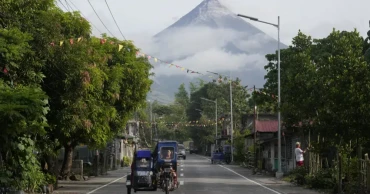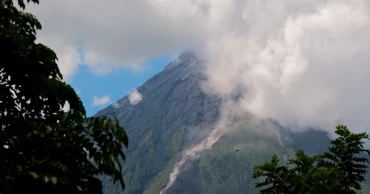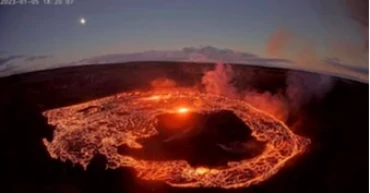volcano
Philippine villages evacuated after major volcanic eruption
About 87,000 people were being evacuated in a central Philippine region Tuesday a day after a volcano briefly erupted with a towering ash plume and superhot streams of gas and debris hurtling down its western slopes.
The latest eruption of Mount Kanlaon on central Negros island did not cause any immediate casualties, but the alert level was raised one level, indicating further and more explosive eruptions may occur.
Earthquake activity near Alaskan Volcano sparks concerns
Volcanic ash fell on a wide area, including Antique province, more than 200 kilometers (124 miles) across seawaters west of the volcano, obscuring visibility and posing health risks, Philippine chief volcanologist Teresito Bacolcol and other officials said by telephone.
At least six domestic flights and a flight bound for Singapore were canceled and two local flights were diverted in the region Monday and Tuesday due to Kanlaon’s eruption, according to the Civil Aviation Authority of the Philippines.
The mass evacuations were being carried out urgently in towns and villages nearest the western and southern slopes of Kanlaon which were blanketed by its ash, including in La Castellana town in Negros Occidental where nearly 47,000 people have to be evacuated out of a 6-kilometer (3.7-mile) danger zone, the Office of Civil Defense said.
The far side of the moon once had erupting volcanoes too
More than 6,000 have moved to evacuation centers aside from those who have temporarily transferred to the homes of relatives in La Castellana by Tuesday morning, the town’s mayor, Rhumyla Mangilimutan, told The Associated Press by telephone.
Disaster-response contingents were rapidly establishing evacuation centers and seeking supplies of face masks, food and hygiene packs ahead of the Christmas season, traditionally a peak time for holiday travel and family celebrations in the largely Roman Catholic nation.
Authorities also shut schools and imposed a nighttime curfew in the most vulnerable areas.
The Philippines’ Institute of Volcanology and Seismology said the nearly four-minute eruption of Kanlaon volcano on Monday afternoon had caused a pyroclastic density current — a superhot stream of gas, ash, debris and rocks that can incinerate anything in its path.
“It's a one-time but major eruption,” Bacolcol told the AP, adding that volcanologists were assessing if Monday's eruption spewed old volcanic debris and rocks clogged in and near the summit crater or was caused by rising magma from underneath.
Few volcanic earthquakes were detected ahead of Monday's explosion, Bacolcol said.
The alert level around Kanlaon was placed on Monday to the third-highest of a five-step warning system, indicating “magmatic eruption" may have begun and may progress to further explosive eruptions.
Philippine villagers flee ashfall, sight of red-hot lava from erupting Mayon volcano
The 2,435-meter (7,988-foot) volcano, one of the country’s 24 most-active volcanoes, last erupted in June sending hundreds of villagers to emergency shelters.
In 1996, three hikers were killed near the peak and several others were later rescued when Kanlaon erupted without warning, officials said.
Located in the so-called Pacific “Ring of Fire,” a region prone to earthquakes and volcanic eruptions, the Philippines is also lashed by about 20 typhoons and storms a year and is among the countries most prone to natural disasters.
1 year ago
Philippine villagers flee ashfall, sight of red-hot lava from erupting Mayon volcano
Truckloads of villagers on Tuesday fled Philippine communities close to the erupting Mayon volcano, traumatized by the sight of red-hot lava flowing down its crater and fearful of sporadic blasts of ash.
Nearly 15,000 people have left the mostly poor farming communities within a 6-kilometer (3.7-mile) radius of Mayon's crater in northeastern Albay province in forced evacuations since volcanic activity spiked last week. Albay's governor extended the danger zone by a kilometer (more than half a mile) on Monday and asked thousands of residents to be ready to move anytime.
Also Read: Philippines’ Mayon Volcano spews lava down its slopes in gentle eruption putting thousands on alert
But many opted to flee from the expanded danger zone even before the mandatory evacuation order.
"There's lava and ashfall already," Fidela Banzuela, 61, said from a navy truck where she, her daughter, grandchildren and neighbors clambered up after leaving their home in San Fernando village close to Mayon. "If the volcano explodes, we won't see anything because it would be so dark."
Her daughter, Sarah Banzuela, fled with her two children, including a 2-year-old who has asthma, which she said could be triggered back by volcanic ash that rained down on their village over the weekend.
Also Read: Philippines evacuates people near Mayon Volcano, where more unrest indicates eruption may be coming
"There's ashfall already and, at night, there's red-hot lava from the volcano that seems to be moving closer to us," Sarah Banzuela, 22, told The Associated Press. She and her mother arrived at a grade school turned into an evacuation center teeming with other displaced villagers.
After days of showing signs of renewed restiveness, including a swarm of rockfalls and a bright-orange crater glow visible at night, Mayon began expelling lava Sunday night, which flowed slowly down two gulleys on its southeastern slope, government volcano experts said.
An ash plume that shot up to 328 feet (100 meters) at dawn on Tuesday drifted southeastward with the wind toward some villages, said Teresito Bacolcol, director of the Philippine Institute of Volcanology and Seismology.
Also Read: Philippines warns of possible flooding, landslides as Typhoon Mawar slowly passes to north
An AP video showed a boulder getting ripped from the side of a dome of lava in Mayon's crater then plunging and breaking into smaller red-hot pieces as it rolled down and smashed onto other stones on the volcano's steep slope.
The 2,462-meter (8,077-foot) Mayon is a top tourist draw in the Philippines because of its picturesque conical shape but is the most active of 24 known volcanoes in the archipelago. It last erupted violently in 2018, displacing tens of thousands. In 1814, Mayon's eruption buried entire villages and left more than 1,000 people dead.
With its peak often shrouded by wisps of passing clouds, Mayon appeared calm on Tuesday, but Bacolcol told AP that lava was continuing to flow slowly down its slopes but could not easily be seen under the bright sun.
The volcano had been raised to alert level three on a five-step warning system last Thursday, meaning a hazardous eruption is possible in weeks or days.
The eruption is the latest natural calamity to test the administration of President Ferdinand Marcos Jr., who took office in June last year and inherited an economy that was shattered by two years of the coronavirus pandemic, which also deepened poverty and unemployment. He has deployed some of his Cabinet officials to Albay to help distribute food aid to and reassure displaced villagers.
Liza David Balbin fled with her children to an emergency shelter in Santo Domingo town after she got scared of Mayon's lava emissions and her farming community of San Antonio was hit by ashfall. The 48-year-old housewife said the government should find an effective way of relocating poor Filipinos like her away from volcanoes, mountainsides where landslides are common and coastlines that are lashed by tidal waves.
In 1991, Balbin witnessed Mount Pinatubo blowing its top in one of the biggest volcanic eruptions of the 20th century. The massive ashfall and volcanic mudflows wiped out her village and outlying communities in Pampanga province north of Manila. She survived and years later married a man who took her to his home province of Albay, where they lived in an impoverished village not far from Mayon.
"I escaped from Pinatubo then ended up near Mayon volcano," she told AP with a laugh. "Why is my life like this?"
"If only we've got money, we would have left that danger zone and built a house far away," said Balbin, who makes a living doing laundry. "Now we're in an evacuation camp again and it's really been a difficult life. This is too much."
2 years ago
Philippines’ Mayon Volcano spews lava down its slopes in gentle eruption putting thousands on alert
The Philippines' most active volcano was gently spewing lava down its slopes Monday, alerting tens of thousands of people they may have to quickly flee a violent and life-threatening explosion.
More than 12,600 people have left the mostly poor farming communities within a 6-kilometer (3.7-mile) radius of Mayon Volcano's crater in mandatory evacuations since volcanic activity increased last week. But thousands more remain within the permanent danger zone below Mayon, an area long declared off-limits to people but where generations have lived and farmed because they have nowhere else to go.
With the volcano beginning to expel lava Sunday night, the high-risk zone around Mayon may be expanded should the eruption turn violent, said Teresito Bacolcol, director of the Philippine Institute of Volcanology and Seismology. Bacolcol said if that happens, people in any expanded danger zone should be prepared to evacuate to emergency shelters.
Also Read: Philippines evacuates people near Mayon Volcano, where more unrest indicates eruption may be coming
2 years ago
Philippines evacuates people near Mayon Volcano, where more unrest indicates eruption may be coming
Philippine troops, police and rescue workers began forcibly evacuating residents near Mayon Volcano on Friday as its increasing unrest indicated a violent eruption of one of the country's most active volcanoes is possible within weeks or days.
The area within a 6-kilometer (3.7-mile) radius of Mayon's crater is supposed to be off-limits due to possible volcanic emissions, lava flows, rockfalls and other hazards. But many poor villagers have built houses and tended farms in Mayon's danger zone over the years.
President Ferdinand Marcos Jr. said an evacuation of residents from the permanent danger zone was underway and promised to provide aid to the displaced until the crisis ended.
Also Read: Philippines warns of possible flooding, landslides as Typhoon Mawar slowly passes to north
"Right now, what we are doing is preparing and moving people away from the area so that, should the time come, I hope it doesn't happen…we're ready," Marcos told reporters. "But unfortunately science tells us that may happen because the lid or the cap on top of the lava is slowly rising."
Authorities had raised the alert level for the volcano in northeastern Albay province Thursday after superheated streams of gas, debris and rocks cascaded down its upper slope, indicating activity below the surface that could precede a hazardous eruption.
Conditions have advanced a little bit more Friday, although lava hasn't started to flow, Marcos said.
The numbers of residents being evacuated weren't immediately available.
A tourist draw for its picturesque conical shape, 2,462-meter (8,077-feet) Mayon last erupted violently in 2018, displacing tens of thousands of villagers.
Government volcano experts raised the alert level around Mayon to the third of a five-step warning system Thursday after detecting an increasing number of rockfalls and at least two volcanic earthquakes in recent days.
Six brief volcanic gas and ash emissions streamed down the volcano's southern gullies about 2 kilometers (1.2 miles) from the crater Friday. Numerous rockfalls and thin ash and steam plumes that drifted south were also observed, the government volcanology institute said.
Mayon is at "a relatively high level of unrest as magma is at the crater and hazardous eruption is possible within weeks or even days," the institute said in its latest update Friday morning.
Mayon is one of the most restive of two dozen active volcanoes across the Philippines.
Officials also were closely monitoring Taal Volcano south of Manila and Mount Kanlaon on central Negros island due to renewed signs of restiveness.
A number of villages in three towns near Taal suspended classes Wednesday due to thick smog emanating from the volcano and residents were advised to limit outdoor activities and wear masks for protection.
The Philippines lies along the Pacific "Ring of Fire," the area around the ocean rim where tectonic plates meet that is prone to earthquakes and volcanic eruptions. A long-dormant volcano, Mount Pinatubo, blew its top north of Manila in 1991 in one of the biggest volcanic eruptions of the 20th century, killing hundreds of people.
2 years ago
Indonesia’s Merapi volcano spews hot clouds in new eruption
Indonesia’s Mount Merapi erupted Saturday with avalanches of searing gas clouds and lava, forcing authorities to halt tourism and mining activities on the slopes of the country’s most active volcano.
Merapi, on the densely populated island of Java, unleashed clouds of hot ash and a mixture of rock, lava and gas that traveled up to 7 kilometers (4.3 miles) down its slopes. A column of hot clouds rose 100 meters (yards) into the air, said the National Disaster Management Agency’s spokesperson Abdul Muhari.
The eruption throughout the day blocked out the sun and blanketed several villages with falling ash. No casualties have been reported.
It was Merapi’s biggest lava flow since authorities raised the alert level to the second-highest in November 2020, said Hanik Humaida, the head of Yogyakarta’s Volcanology and Geological Hazard Mitigation Center.
Also Read: Indonesia landslide deaths climb to 21; dozens still missing
She said residents living on Merapi’s slopes were advised to stay 7 kilometers (4.3 miles) away from the crater’s mouth and be aware of the danger posed by lava.
Tourism and mining activities were halted.
The 2,968-meter (9,737-foot) mountain is about 30 kilometers (18 miles) from Yogyakarta, an ancient center of Javanese culture and the seat of royal dynasties going back centuries. About a quarter million people live within 10 kilometers (6 miles) of the volcano.
Merapi is the most active of more than 120 active volcanoes in Indonesia and has repeatedly erupted with lava and gas clouds recently. Its last major eruption in 2010 killed 347 people and displaced 20,000 villagers.
Also Read: Indonesia fuel depot fire kills 19; 3 still missing
Indonesia, an archipelago of 270 million people, is prone to earthquakes and volcanic activity because it sits along the “Ring of Fire,” a horseshoe-shaped series of seismic fault lines around the Pacific Ocean.
An eruption in December 2021 of Mount Semeru, the highest volcano on Java island, left 48 people dead and 36 missing.
2 years ago
Hawaii's Kilauea volcano erupts again, summit crater glows
Hawaii's Kilauea began erupting inside its summit crater Thursday, the U.S. Geological Survey said, less than one month after the volcano and its larger neighbor Mauna Loa stopped releasing lava.
The Hawaiian Volcano Observatory detected a glow in webcam images indicating Kilauea had begun erupting inside Halemaumau crater at the volcano's summit caldera, the agency said.
Kilauea’s summit is inside Hawaii Volcanoes National Park and away from residential communities.
Earlier Thursday, the U.S. Geological Survey raised the alert level for Kilauea due to signs that magma was moving below the summit surface, an indication that the volcano might erupt.
Kilauea is one of the world's most active volcanoes. It last erupted for 16 months starting in September 2021. For about two weeks starting Nov. 27, Hawaii had two volcanoes spewing lava side by side when Mauna Loa erupted for the first time in 38 years. Both volcanoes stopped erupting at about the same time.
During the twin eruption, visitors to Hawaii Volcanoes National Park were able to see lava from both eruptions at the same time.
Read more: Hawaii's Kilauea volcano erupts, lava fountains form in park
“It was a beautiful eruption, and lots of people got to see it, and it didn’t take out any major infrastructure and most importantly, it didn’t affect anybody’s life,” said Ken Hon, the Hawaiian Volcano Observatory’s scientist in charge.
Mauna Loa lava didn’t pose a threat to any communities, but got within 1.7 miles (2.7 kilometers) of a major highway connecting the east and west sides of the island. A 2018 Kilauea eruption destroyed more than 700 residences.
The observatory planned to continue monitoring the volcanoes for signs of renewed activity. Hon previously said there is generally a three-month “cooling off” period before scientists consider an eruption to be complete.
It was unclear what connection there could be to the volcanoes stopping their eruptions around the same time. The volcanoes can be seen at the same time from multiple spots in Hawaii Volcanoes National Park near Kilauea’s caldera.
Read more: World’s largest active volcano Mauna Loa erupts in Hawaii
Scientists planned to look at data to study the relationship between the two volcanoes, Hon previously said.
For Native Hawaiians, volcanic eruptions have deep cultural and spiritual significance. During Mauna Loa’s eruption, many Hawaiians took part in cultural traditions, such as singing, chanting and dancing to honor Pele, the deity of volcanoes and fire, and leaving offerings known as “hookupu.”
2 years ago
World’s largest active volcano Mauna Loa erupts in Hawaii
The world’s largest active volcano was erupting Monday and wasn’t immediately threatening communities on Hawaii’s Big Island, but officials warned residents to be ready for worse.
Many current residents weren’t living there when Mauna Loa last erupted 38 years ago. The U.S. Geological Survey warned the roughly 200,000 people on the Big Island that an eruption “can be very dynamic, and the location and advance of lava flows can change rapidly.”
The eruption began late Sunday night following a series of fairly large earthquakes, said Ken Hon, the scientist-in-charge at the Hawaiian Volcano Observatory.
There’s been a surge of development on the Big Island in recent decades — its population has more than doubled, from 92,000 in 1980.
Most of the people on the island live in the city of Kailua-Kona to the west of the volcano, which has about 23,000 people, and Hilo to the east, with about 45,000. Officials were most worried about several subdivisions about 30 miles to the south of the volcano, which are home to about 5,000 people.
A time-lapse video of the eruption from overnight showed lava lighting up one area, moving across it like waves on the ocean.
The U.S. Geological Survey said that the eruption had migrated to a rift zone — a place where the mountain rock is cracked and relatively weak — making it easier for magma to emerge.
An eruption from the zone could send lava toward the county seat of Hilo or other towns in East Hawaii but it could take the lava weeks or months to reach populated areas.
“We don’t want to try and second-guess the volcano,” Hon said. “We have to let it actually show us what it’s going to do and then we inform people of what is happening ASAP.”
Hawaii County Civil Defense announced that it had opened shelters because it had reports of people evacuating from along the coast on their own initiative.
The average Mauna Loa eruption is not typically prolonged, lasting a couple of weeks, Hon said.
“Typically, Mauna Loa eruptions start off with the heaviest volume first,” Hon said. “After a few days, it starts to calm down a little bit.”
The USGS warned residents at risk from Mauna Loa lava flows to review their eruption preparations. Scientists had been on alert because of a recent spike in earthquakes at the summit of the volcano, which last erupted in 1984.
Portions of the Big Island were under an ashfall advisory issued by the National Weather Service in Honolulu, which said up to a quarter-inch (0.6 centimeters) of ash could accumulate in some areas.
Mauna Loa is one of five volcanoes that together make up the Big Island of Hawaii, which is the southernmost island in the Hawaiian archipelago.
Mauna Loa, rising 13,679 feet (4,169 meters) above sea level, is the much larger neighbor of Kilauea, which erupted in a residential neighborhood and destroyed 700 homes in 2018. Some of its slopes are much steeper than Kilauea’s, so lava can flow much faster when it erupts.
During a 1950 eruption, the mountain’s lava traveled 15 miles (24 kilometers) to the ocean in fewer than three hours.
Tourism is Hawaii’s economic engine but Roth predicted few problems for those on vacation during the eruption.
“It will be spectacular where it is, but the chances of it really interrupting the visitor industry — very, very slim,” he said.
For some, the eruption might cut down on some travel time, even if there is more volcanic smog caused by higher sulfur-dioxide emissions.
Read more: Hawaii's Kilauea volcano erupts, lava fountains form in park
“But the good thing is you don’t have to drive from Kona over to Hawaii Volcanoes National Park to see an eruption anymore,” Roth said. “You can just look out your window at night and you’ll be able to see Mauna Loa erupting.”
Julia Neal, owner of Pahala Plantation Cottages, said the eruption brings some relief after many preparedness meetings, and much wondering about what the volcano will do.
“It’s exciting,” she said. “It’s kind of a relief that it’s happening and we’re not waiting for it to happen.”
A few future guests from the U.S. mainland called Neal “asking me to make a prediction, which I can’t,” she said. “So I said, just stand by.”
Read more: Philippine volcano makes phreatic eruption anew within one week
3 years ago
Philippine volcano makes phreatic eruption anew within one week
A volcano approximately 600 km southeast of the Philippine capital spewed ash before dawn on Sunday, a week after a phreatic eruption that prompted authorities to raise the alert level to 1 and evacuate residents to safety.
The Philippine Institute of Volcanology and Seismology said it detected a phreatic explosion again in Bulusan volcano in Sorsogon province at 3:37 a.m. local time on Sunday.
"The event lasted 18 minutes based on the seismic record, but the eruption plume was not visible in camera monitors," the institute said.
On June 5, authorities evacuated more than 200 residents near the volcano after spilling a grey plume about a kilometer high into the sky. The "phreatic eruption" lasted approximately 17 minutes and ashfall was reported in towns near the volcano.
READ: First aid flights leave for Tonga after big volcano eruption
The volcano remains on alert level 1 on a scale of 5, meaning that the volcano is still in an "abnormal condition." The institute urged people to stay away from the four-kilometer "permanent danger zone."
The institute also advised pilots to avoid flying close to the volcano's summit as ash from any sudden phreatic eruption can be hazardous to aircraft.
Bulusan volcano is one of the Philippines' most active volcanoes. In January 2018, the volcano spewed ash about 2.5 km high into the sky.
3 years ago
Indonesia’s volcano spews ash, gas; 1 dead, dozens hurt
The highest volcano on Indonesia’s most densely populated island of Java spewed thick columns of ash, searing gas and lava down its slopes in a sudden eruption triggered by heavy rains on Saturday. At least one villager died from burns and dozens were hospitalized.
Mount Semeru’s eruption in Lumajang district in East Java province left several villages blanketed with falling ash.
A thunderstorm and days of rain, which had eroded and finally collapsed the lava dome atop the 3,676-meter (12,060-foot) Semeru, triggered an eruption, said Eko Budi Lelono, who heads the geological survey center.
He said flows of searing gas and lava traveled up to 800 meters (2,624 feet) to a nearby river at least twice on Saturday. People were advised to stay 5 kilometers (3.1 miles) from the crater’s mouth, the agency said.
“Thick columns of ash have turned several villages to darkness,” said Lumajang district head Thoriqul Haq. Several hundred people were moved to temporary shelters or left for other safe areas, he said, adding that power blackout hampered the evacuation.
The debris and lava mixed with the rainfall formed thick mud that destroyed the main bridge connecting Lumajang and the neighboring district of Malang, as well as a smaller bridge, Haq said.
Despite an increase in activity since Wednesday, Semeru’s alert status has remained at the third highest of four levels since it began erupting last year, and Indonesia’s Volcanology Center for Geological Hazard Mitigation did not raise it this week, Lelono said.
READ: Hawaii's Kilauea volcano erupts, lava fountains form in park
One man died from severe burns, and 41 others were hospitalized with burn injuries, said Indah Masdar, the deputy district head. She said two villagers were reported missing and several sand miners were trapped in isolated areas along the village river.
Entire houses in Curah Kobokan village were damaged by volcanic debris, Masdar said.
Television reports showed people screaming and running under a huge ash cloud, their faces wet from rain mixed with volcanic dust. The last time Semeru erupted in January, there were no casualties.
READ: Visit Boga Lake, Bandarban: Natural pool from fairy tales or sleeping volcano
Indonesia, an archipelago of more than 270 million people, is prone to earthquakes and volcanic activity because it sits along the Pacific “Ring of Fire,” a horseshoe-shaped series of fault lines.
4 years ago
La Palma's volcanic eruption is going strong 3 weeks later
Three weeks since its eruption upended the lives of thousands, the volcano on Spain’s La Palma island is still spewing out endless streams of lava with no signs of ceasing.
Authorities on Sunday monitored a new stream of molten rock that has added to the destruction of over 1,100 buildings. Anything in the path of the lava — homes, farms, swimming pools and industrial buildings in the largely agricultural area — has been consumed.
The collapse Saturday of part of the volcanic cone sent a flood of bright red lava pouring down from the Cumbre Vieja ridge that initially cracked open on Sept. 19. The fast-flowing stream carried away huge chunks of lava that had already hardened. An industrial park was soon engulfed.
Read: Hawaii's Kilauea volcano erupts, lava fountains form in park
“We cannot say that we expect the eruption that began 21 days ago to end anytime soon,” said Julio Pérez, the regional minister for security on the Canary Islands.
La Palma is part of Spain’s Canary Islands, an Atlantic Ocean archipelago off northwest Africa whose economy depends on the cultivation of the Canary plantain and tourism.
The new rivers of lava have not forced the evacuation of any more residents since they are all so staying within the exclusion zone that authorities have created. Some 6,000 residents were promptly evacuated after the initial eruption.
Government experts estimated that the largest of the lava flows measures 1.5 km (.9 miles) at its widest point, while the delta of new land being formed where lava is flowing into the Atlantic has reached a surface of 34 hectares (84 acres).
The scientific committee advising the government said that if the delta continues to grow outwards into the sea, parts of it could break off. That would generate explosions, gas emissions and large waves, committee spokeswoman José María Blanco said, but should not represent a danger to those outside the no-go zone.
Read: California wildfire dangers may be spreading south
The Canary Islands' tourism industry was already hard hit by the pandemic, and officials were urging tourists not to keep staying away.
“This eruption is impacting a part of the island, but La Palma is still a safe place and can offer a lot to those who visit,” said Mariano Hernández, the island’s leading authority.
The last eruption on La Palma 50 years ago lasted just over three weeks. The last eruption on all the Canary Islands occurred underwater off the coast of El Hierro island in 2011 and lasted five months.
4 years ago







.png)
.jpg)








